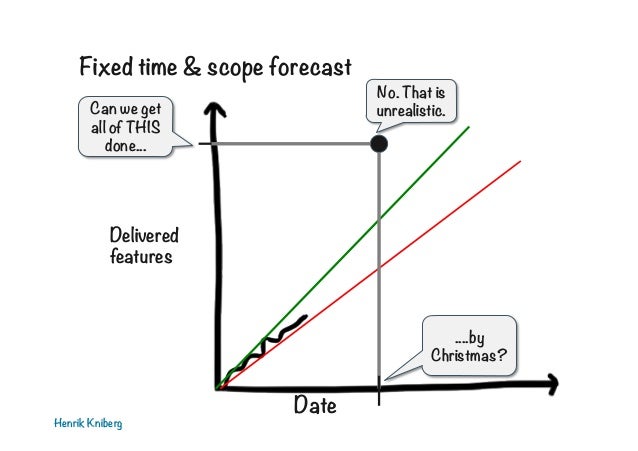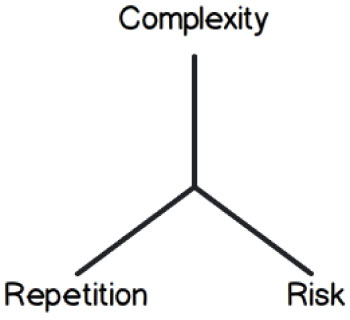Estimation: When predictability is defined by the deadlines
"It doesn't matter, all this -estimating- effort is lost time, since they'll -Product Owners & Stakeholders- have to accommodate to the truth, and we'll have to do overtime to get there either way" - an anonymous developerThis phrase is something I've heard in my agile coach experience. Teams accepting the fact that externals do not understand how estimating should work, already abandoning all hope to make a change in the way stuff is done.
The first thing that waved in my mind as a warning flag, is the "Us vs Them" perception. Having sides, is a clear notice that we are not working towards the same goal, or under the same understanding of what "having the same" goal really means. It's my hope that with this short note, I can help as many Developers, Product Owners, Product Managers and Stakeholders to get to the same page once again.
How is it badly used
Take a look on some of the example situations I can think of top of my mind that you could be finding in your Teams-Managers-Stakeholder relation:- Ask for an estimation of a long term project, hold everyone accountable on that.
- Ask for an estimation of a project, knowing beforehand that there's no negotiation point on the scope nor the deadlines.
- Optimistic with the undefined: People raise risks but can't measure the uncertainties, therefore they tend to be optimistic with their assessment, the risk "is not being raised enough" so it loses focus.
- "You regularly deliver this much, so less than this raises warning flags".
What really is
- An estimate is precise, but not accurate.
 |
| In this case S or M would depend on how the risks might impact, M would be to play safe, and be precise. |
- If you work with a fixed deadline:
- If you work with a fixed scope instead:
- An estimate is relative.
Why not just use working hours? Everyone knows the size of an hour, right? Well yes, but not all size a particular work in the same amount of hours.
- An estimate is a mix of complexity, repetition and risk.
Let's say we have a team of two made of a neurosurgeon and a 7 year kid, with two tasks: performing a "standard" brain surgery and lick one thousand stamps, the team could agree that both stories have a relative estimate of 8 points, the complexity and repetition of each one are dissimilar. And where do I place the higher risk? That should be shown in width of the range when more risks are present more width you'll find between best and worst case scenario.
- An estimate may change as we add more knowledge.
 |
| It's unrealistic to expect to finish something at the estimated time, when the estimation is being done at the beginning of the project. |
- An estimate is a communication that should be alive in an agile context.
Estimating for iterations.
We've seen how to use the estimates on a long term goal, now let's analyze what happens on regular intervals.On an iteration analysis, the estimates are used to define the capacity in story points that each team can take. Now regularly, we fall in the pit of saying "this is the number we've been doing, so we need to get this same much". Now this is another partial truth, because it's always good additional info to consider but under no circumstance we should work towards aiming for a certain number.
You should aim for as much as you feel confident you can commit to. You might (and will) receive a challenge on the final iteration estimate, if it differs from the regular one, and sometimes those challenges will prove to be healthy, since it'll get the team to reconsider previous analysis that they did. The team needs to be able to explain why they have those changes. Again, transparent communication and openness are some of the root values.
My personal experience
Something I did to work on this situation, was to attack what I thought is the root of the problem: have them looking towards the same goal: I started generating the insight within the developers to communicate in a more valuable way, by making powerful questions: "Are you on track with what you originally estimated?" "Do you know when is the deadline and what needs to be delivered?". Now the powerful questions for the Product owners and managers are different: "Do you trust the teams to have clear the path you have planned for the product and the deadlines we have?". With that I triggered the thoughts that generates their awareness, and ignited the will to action from those who are most fit to do it.
Wrapping up
Going back to our original phrase, estimation is only lost time if being predictable does not make sense for you. Sure, when the actual daily trenches fight happens, the estimates could have important deviations from the originals; but a continuous, open, and flowing communication is key to define if the now updated path we are moving forward together, is the best one at a daily, tactical and strategy level. It's better if we all can accommodate to the truth as fast as we can, to take the best decisions as a single team, with a single vision.And on overtime: overtime is a tool that if considered standard work model on a regular pace, might be evidence that you have a greater problem in the way the work is being organized. I encourage you to ask your team(s) for a root cause analysis retrospective on what this situation is popping up at a regular pace. One thing that happened to me in this regard is that I ended up finding out that the company was pushing for a fixed scope and fixed time, which goes against the agile perspective, but that's another story which hopefully I'll address in one of my next entries.



Excellent post, Ariel! Reading about your personal experience is very valuable.
ReplyDeleteThanks a lot for your feedback Barbara, I'll keep that in mind for my future posts as well!.
Delete